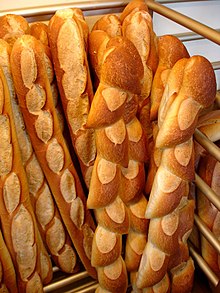Baguette

Baguettes are long thin loaves of bread popular in France, but now common in many other countries. Usually, they are made of white bread. Baguettes usually have a hard crust on the outside but soft bread on the inside.
French traditions say that bread may only contain the following four things: flour, water, yeast and salt. Anything containing more than those things must not be called bread.
A baguette is about 5-6 cm wide, 3 to 4 cm high, and about 65 cm long. Such a baguette usually weighs about 250 grams.[1] It is common to dip the bread into olive oil when it is eaten.
History
[change | change source]The baguette is thought as to have come from France, but it actually came from Vienna.[2] In the middle of the nineteenth century, steam ovens had just been brought into use. This allowed loaves to be made with a crispy crust and the white centre, similar to today's baguettes.[3]
Later, in 1920, a law was passed that did not let bakers work before 4 am. This made it impossible to make a larger loaf in time for their customers' breakfasts. The longer, thinner baguette helped solve this problem because it could be prepared and baked much faster.[3]
Description
[change | change source]Outside France, the baguette is also called a 'French stick'. It is a loaf of bread, up to a metre long but only about four to five centimetres in diameter. The baguette is a symbol of France.
Baguettes are eaten as a sandwich cut in half lengthwise. They are also eaten for breakfast (usually with jam or chocolate spread).
A loaf the same length as a baguette but thicker (about 8-10 centimetres diameter) is known as 'pain'. A thin version of the baguette is called 'ficelle'.
Even in France there is a difference between a traditional baguette and a 'supermarket' baguette.
Baguette has the same texture as the Greek bread Tsoureki.[4]
References
[change | change source]- ↑ "baguette: Definition from Answers.com". answers.com. Retrieved 1 May 2010.
- ↑ "Food timeline: history of bread". Lynne Olver 1999. Retrieved 16 July 2010.
- ↑ 3.0 3.1 "French bread and french baguette - food from france". francethisway.com. Archived from the original on 3 May 2010. Retrieved 1 May 2010.
- ↑ "No Meal is Complete Without Greek Bread!". 26 June 2015.
